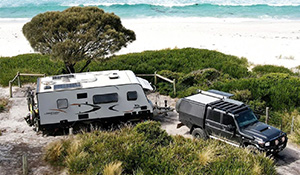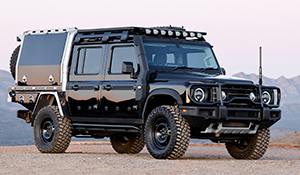How to Drive on Snow and Ice
Words: via Practical Motoring

Snow in Australia isn’t all that common and it’s more likely you’ll be dealing with icy roads and cold morning starts where the mercury has dropped below zero overnight than white fluffy snow on the road.

What gear to be in
One of the first things you’ll need to know is it is not a wise to sit in first-gear when driving on ice because of the idea some say it offers more torque and thus more grip…Let’s knock this one on the head right away. When you’re trying to pull away in slippery conditions, selecting the lowest gear possible is not a good idea and that’s because low gears provide more torque at the wheels which can overwhelm the tyre’s grip on a slippery surface and cause the vehicle to slip.
So, selecting a higher gear and a nice even throttle application is generally the best way to pull away on ice. If your vehicle is automatic then it’ll possibly have a snow mode, selecting this will see the transmission automatically select a higher gear to try and prevent slip.

Traction control
Another thing heroes suggest you do whenever you get into a car is switch off the traction and stability controls. Don’t ever do this unless your name begins with The and ends in Stig. On an icy road, your car’s traction and stability controls will do a better job than you of keeping your car pointing in the right direction.
That said, you might want to temporarily switch of traction and stability controls if you’re trying to get going in deep snow or sloppy mud (although clearing any muck from in front of your tyres and laying down some sort of traction, be it a hessian sack or something similar, or better yet, something like Maxtrax); if you’re driving an SUV or 4×4 with a snow mode (although sometimes a wet grass mode might be better), make sure your vehicle is in that mode as it will do all the throttle, transmission and traction and stability adjustments for you.

Take it from someone who was in a car when their mate slammed on the brakes on an icy road. We simply started sliding, although the vehicle had ABS, traction and stability controls, so the driver was still able to steer without simply sliding out of control. But, what my mate should have done was, first, anticipate the car ahead of him slowing down (he could see its brake lights in the distance) and instead of jumping on the brakes, ease off the throttle and allow engine braking to help slow the car. This way we would have stayed in much more control than we were.
Driving on ice (the surface) can be very dangerous and you can lose control at almost 0km/h. My old man, in a pre-ABS car locked up the brakes and we slid off the road (he could of cadence braked, which is sort of a manual version of ABS only it’s not as good) but everything happened so quickly he didn’t have the chance); it’s only when you’ve experienced something like that that you can fully appreciate just how good modern traction and stability controls systems are and what a lifesaver ABS is.

What speed to drive at
It’s vital when driving on icy roads that you lower your speed by at least a third of the dry road speed limit and sometimes more. While a road cleared of snow will generally have a frosty look and thus be easy to see that there’s ice on the road, black ice can be virtually impossible to see. It tends to sit in shaded sections of road, so, if you’re driving in areas where the temperature drops below zero, whether there’s snow or not, then be very careful.

Driving with snow chains
If you’re making a trip to the ski fields then it’s likely you’ll have to fit snow chains to your tyres; you can either hire them or buy them before you head off. If you do buy a set of chains then make sure you buy the correct ones for your vehicle and work out how to fit them before you hit the snow.

Things to check on the car
Indeed, driving on snow and ice in Australia isn’t a particularly common driving scenario but there are plenty of places in Australia where the mercury drops to below-zero overnight causing black ice to form on roads. Similarly, this can impact on things like windscreen wipers, which can freeze to your windscreen. The rubber can rip if you switch on the wipers in this situation. If you know it’s going to be a particularly cold night, you could consider raising your wipers into their upright position; this also works when you’re in alpine areas and it’s snowing. And always carry a de-icer to clear ice from your windscreen. In extreme situations, like when you know snow will fall on your car, then laying a tarp across the windscreen can help to keep it from becoming icy and blanketed in snow.

Similarly, it could be worth adding an anti-freezing additive to your windscreen washer bottle in really cold weather, and the same is true for your radiator, although these are two different types of anti-freeze. You don’t want to just use tap water in the thing and risk it freezing and then cracking your radiator and associated pipe work as it expands.
Again, even if you’re not driving in snow and ice, a cold snap or even just a cold winter can impact on your car. So, checking your tyres when the temperature is fluctuating from below zero overnight to single figures during the day will cause the air pressure in your tyres to drop considerably, so get in a habit of checking them during cold snaps to ensure they’re running at the right pressure.

What fuel to use in the snowy regions
Now we come to fuel. Petrol won’t freeze until it hits about -50-degrees C, but diesel separates and ‘waxes’ as it freezes; generally speaking, its freezing point is around -20-degres C, but you’ll experience problems long before it gets to that temperature. But that’s where the Australian Standards come in, it specifies the maximum temperatures, by region and month for fuels sold in Australia.
If you’re heading into alpine areas then you’ll see Alpine Diesel being sold at petrol stations and this has a much lower cloud point than the non-alpine diesel, maybe around -7-degrees C. Where I live, in the Blue Mountains, when winter sets in we get what’s called Highland Diesel which has a cloud point of around -2-degrees C. You can also get additives to lower the cloud point of your diesel even further. Bothering with cold-weather diesel isn’t something a day-tripper needs to be worried about, only those playing in the snow and leaving their car parked in freezing temperatures overnight should be concerned.









